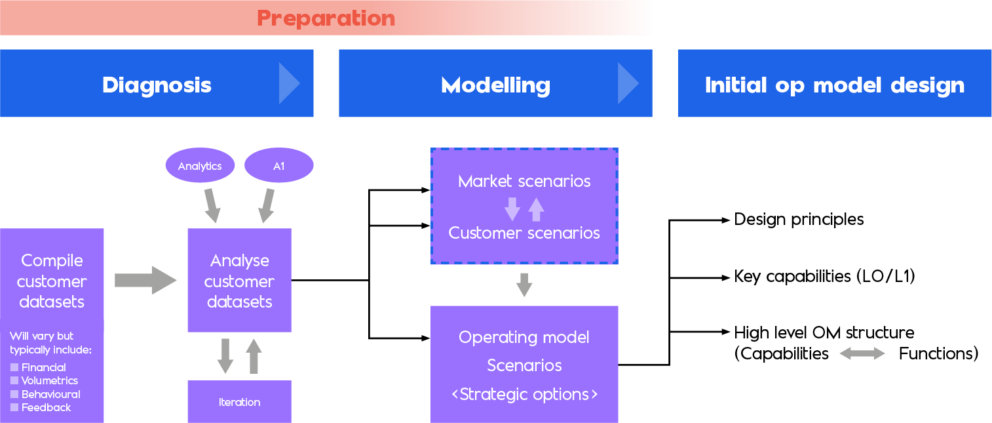“Instead of focusing on the competition, focus on the customer,” Scott Cook, co-founder of Intuit has famously said.
And he isn’t wrong, particularly in an era of increasing technology adoption, where consumer tastes and choices change rapidly. An operating model is the way for companies to deliver a business’s strategy – but if it isn’t adaptable and nimble and able to respond to these rapidly changing customer needs, then something needs to change.
The operating model…
An operating model defines how people, processes, technology, data and insights – derived from that data – are connected and coordinated to achieve strategic business goals. The operating model concept has been around since the 1970s, but is facing one of its greatest challenges in this era of mass digital adoption. Consumers across all industries are using digital technologies to make faster and more-informed buying choices, whilst their expectations of customer service soars.
In fast-moving markets, many organisations are finding that their operating models are rapidly becoming unfit for purpose and in some cases, obsolete – a trend that has been accelerated by the global COVID-19 pandemic. Corporate history is littered with former market leaders (Eastman Kodak, Blockbuster, Sun Microsystems, Yahoo!) that failed to adapt their strategy, business models and operating models to reflect emerging consumer trends. And the pandemic has served to expose weaknesses in the operating models of many UK high street retailers – the likes of Arcadia, Debenhams and Mothercare all bit the dust, due to an under investment in digital and were left exposed with large, expensive real estate portfolios.

Putting customer needs at the heart of the operating model
Organisations can respond to the demands of digitalisation and marketplace disruption by placing customers at the heart of operating model design, implementation and refinement. Think of the central importance of business strategy to organisations. One role of business strategy is defining how a firm intends to sustainably deliver value to its customers. And if a business strategy explains a firm’s approach to customer value creation, an operating model describes how people, processes, technology, data and insights are organised and coordinated to deliver customer value.
So creating customer value must be the basis of operating model design – and there are several practical implications of following this important principle.
The role of diagnostics and insights
The first implication is that the design (or redesign) of an operating model should be preceded by a iterative diagnostic phase that leverages in-depth insights about key customers and customer groups. Applying analytics and artificial intelligence to customer-relevant data sets – including volume-based metrics – will enable organisations to model a range of market or customer scenarios, and potential operating model responses to these scenarios. Other information inputs can be sourced through direct feedback or by conducting A/B tests, which is a research methodology helpful in understanding user experience and engagement.
Once the results from the diagnostic phase have been analysed, the operating model design can be developed around the customer journeys and functional capabilities that reflect the products and services the organisation takes to market. This means clearly defining channels so they facilitate customer journeys, identifying opportunities to break down organisational silos and create cross-functional teams, designing standardised end-to-end processes, and start establishing technological consistency across platforms, IT processes & development tools.
The part automation plays
The adaptability of an operating model in fast-moving market conditions must reflect both a customer-centric approach to design, but also the tools and methodologies used to build and document the model. Accelerated remote working has led to a proliferation of online and cloud-enabled collaboration tools – Mural, Bit AI, Firestage, Mockplus iDoc, Proofhub, to mention a handful.
These tools allow the design process to be simultaneously exposed to multiple teams and enable design changes to be made without the traditional headache of document version control. More sophisticated approaches will leverage computer-aided design (CAD) software that can support complex organisational blueprints, dynamically link multiple operating model artefacts and adjust the construct of the artefacts to reflect changes in underlying data sets (including online customer behaviour and buying patterns).
PPM and scaled agile
Although operating model design / redesign is inherently challenging to frame and implement, sustained implementation progress can be achieved through rigorous project portfolio management and the adoption of scaled agile delivery practices. Implementation risks can be also managed by taking an iterative approach to operating model delivery, with incremental capability refinements delivered through a coordinated sequence of change initiatives. Each operating model ‘release’ is then focused on a discrete set of change priorities which maintains agility and enables the fast resolution of implementation issues and challenges as they arise.
Continuous cycle
Once the implementation of the target operating model is complete, organisations must continue to measure performance and apply appropriate refinement or adjustments to maintain agility, flexibility and relevance – an operating model cannot simply be allowed to stand still. This ongoing loop of analysis, maintenance and upgrade will be supported by the customer data and analytics capabilities that will underpin the success of an organisation’s operating model diagnostic and analysis effort.
This transformation process delivers value by enhancing customer experiences across channels, releasing organisational efficiencies, fostering innovation and supporting employees in providing new ways of working. Organisations can only fully realise these benefits by placing their customers at the heart of operating model design, implementation and refinement.
Want to learn more? If you would like to learn more about how Valcon can help your business with your digital transformation ambition, please email [email protected] and we’ll be in touch right away.













